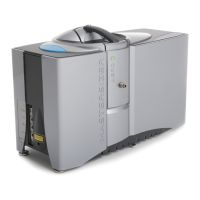Sample preparation guidance Chapter 6
Mastersizer 3000 Page 6-3
Representative sampling
When taking a sample for a measurement, it is vital to ensure that the sample used
is representative of the whole sample. This section gives guidelines.
If the sample is taken from a bottle or container, take care to ensure that it is thor-
oughly mixed. When the sample is a powder, large particles tend to rise to the top
of the container as smaller ones work their way to the bottom.
In most samples there are some large and some small particles, but the majority fall
between these extremes. If a sample is taken from the top of the container, mainly
large particles will be measured. If this is compared to a measurement with the
sample taken from the centre of the container the results will differ noticeably.
If the sample is stored in a container this should be mixed thoroughly before meas-
urement. Do not shake the container as this often increases the separation of the
particles. Instead, hold the container in both hands and gently roll the container,
continually changing its orientation for about 20 seconds. This method works bet-
ter if the container is only half full.
Spinning rifflers
If the distribution of particles within a sample is particularly broad, representative
sampling can be difficult. If problems continue, using a spinning riffler may help.
This is a vibrating hopper which vibrates the sample down a chute.
The act of vibrating the sample causes the larger particles to separate out and travel
down the chute first. At the end of the chute a set of rotating pans collects the sam-
ple evenly. When all of the sample has passed down the chute each collecting pan
will contain a representative sample.
Liquid samples
Liquid samples can also separate out if stored in containers, with larger particles
sinking to the bottom. Again, it’s necessary to mix the sample thoroughly to get a
representative sample. Sample splitters/rifflers are also available for liquid samples.
Beware of using a magnetic stirrer to mix a liquid sample. Large particles tend to
move to the outside of the container due to centrifugal separation, and this can lead
to sample biasing.

